ACC03043 Corporate Governance Report: Financial Crisis and Failures
VerifiedAdded on 2022/11/03
|7
|1550
|95
Report
AI Summary
This report examines corporate governance through the lens of historical corporate collapses in Australia and the implications of the global financial crisis. The first part of the report delves into the failures of Alan Bond, Laurie Connell of Rothwells, and the Girvan Corporation, analyzing the underlying causes of their downfall and assessing whether contemporary corporate governance standards could have prevented these outcomes. The second part explores the corporate governance implications stemming from the global financial crisis, focusing on the role of governance failures in exacerbating the crisis and the need for improved risk management and oversight. The report references academic sources to support its analysis and provides insights into the importance of robust corporate governance in maintaining financial stability and investor confidence. It also highlights the variables of corporate governance that negatively impact risk-taking and financial performance.
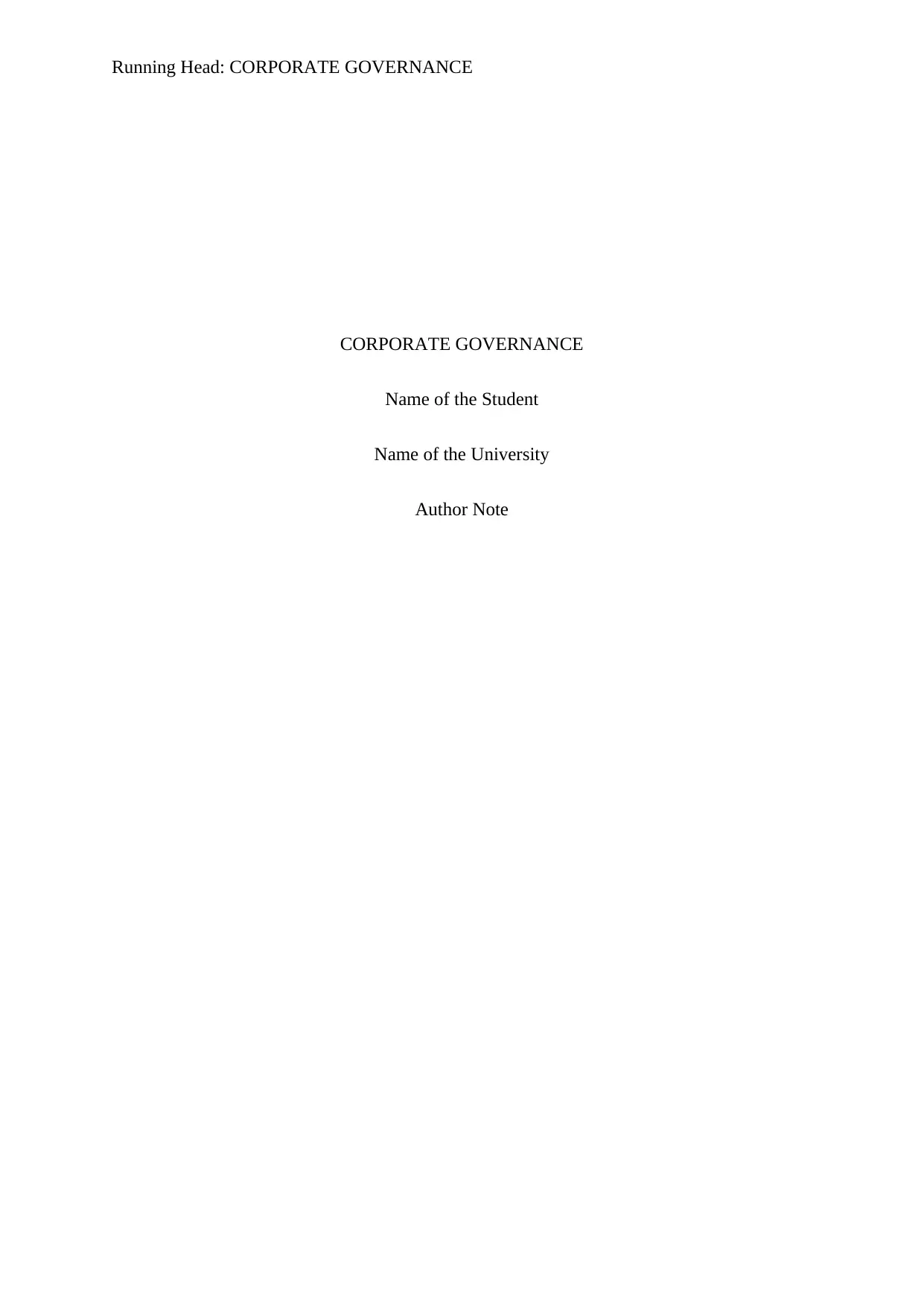
Running Head: CORPORATE GOVERNANCE
CORPORATE GOVERNANCE
Name of the Student
Name of the University
Author Note
CORPORATE GOVERNANCE
Name of the Student
Name of the University
Author Note
Paraphrase This Document
Need a fresh take? Get an instant paraphrase of this document with our AI Paraphraser
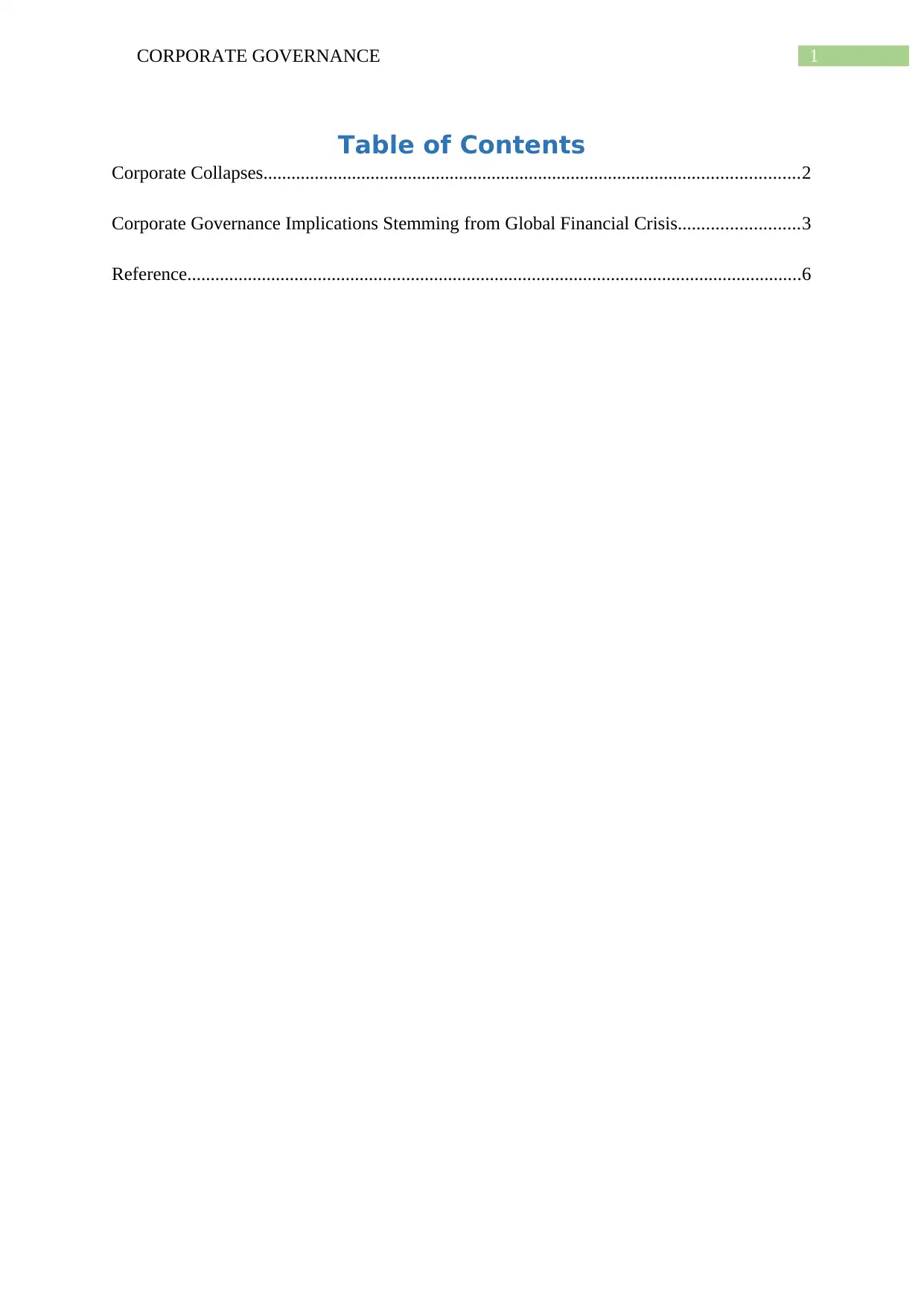
1CORPORATE GOVERNANCE
Table of Contents
Corporate Collapses...................................................................................................................2
Corporate Governance Implications Stemming from Global Financial Crisis..........................3
Reference....................................................................................................................................6
Table of Contents
Corporate Collapses...................................................................................................................2
Corporate Governance Implications Stemming from Global Financial Crisis..........................3
Reference....................................................................................................................................6
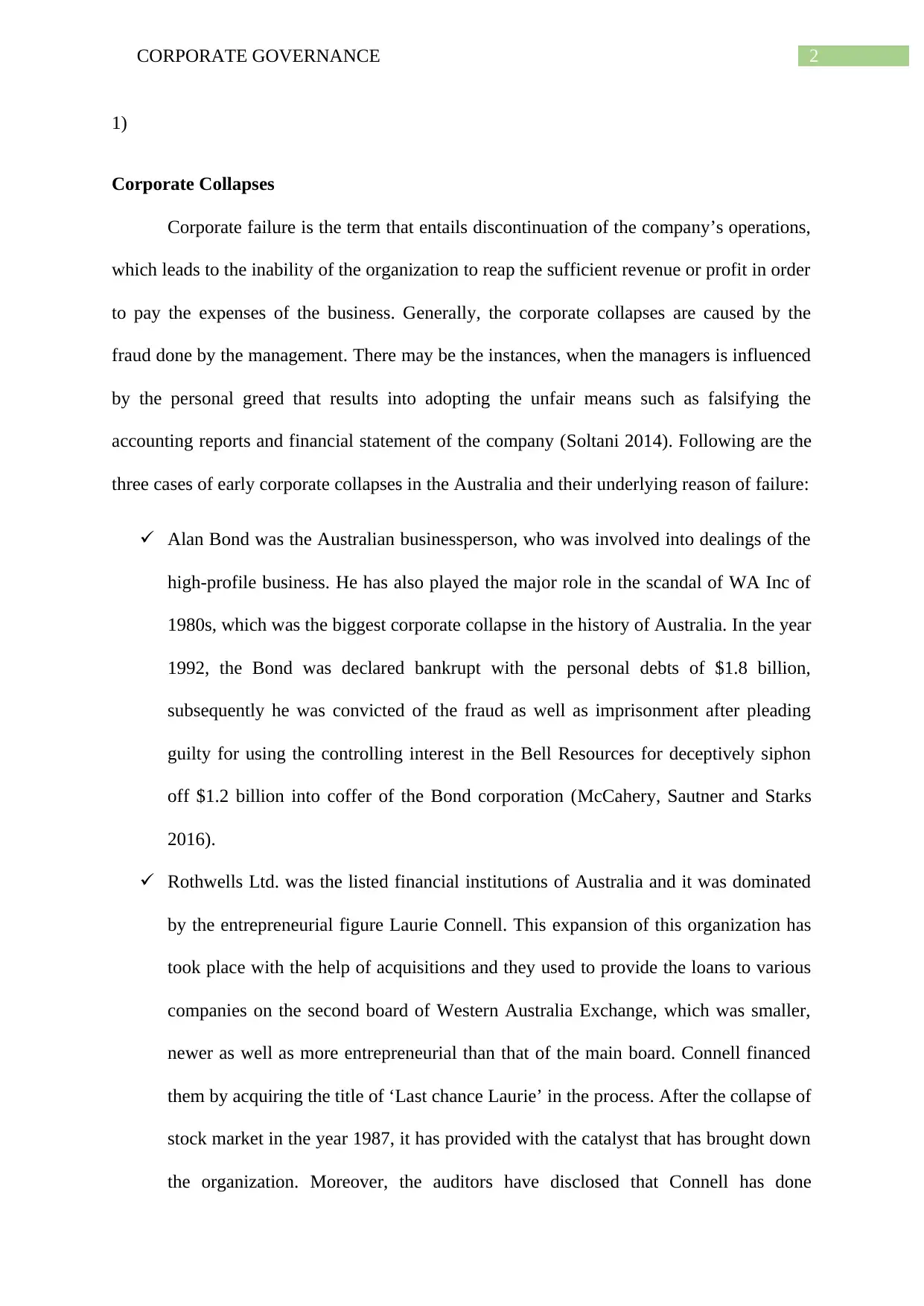
2CORPORATE GOVERNANCE
1)
Corporate Collapses
Corporate failure is the term that entails discontinuation of the company’s operations,
which leads to the inability of the organization to reap the sufficient revenue or profit in order
to pay the expenses of the business. Generally, the corporate collapses are caused by the
fraud done by the management. There may be the instances, when the managers is influenced
by the personal greed that results into adopting the unfair means such as falsifying the
accounting reports and financial statement of the company (Soltani 2014). Following are the
three cases of early corporate collapses in the Australia and their underlying reason of failure:
Alan Bond was the Australian businessperson, who was involved into dealings of the
high-profile business. He has also played the major role in the scandal of WA Inc of
1980s, which was the biggest corporate collapse in the history of Australia. In the year
1992, the Bond was declared bankrupt with the personal debts of $1.8 billion,
subsequently he was convicted of the fraud as well as imprisonment after pleading
guilty for using the controlling interest in the Bell Resources for deceptively siphon
off $1.2 billion into coffer of the Bond corporation (McCahery, Sautner and Starks
2016).
Rothwells Ltd. was the listed financial institutions of Australia and it was dominated
by the entrepreneurial figure Laurie Connell. This expansion of this organization has
took place with the help of acquisitions and they used to provide the loans to various
companies on the second board of Western Australia Exchange, which was smaller,
newer as well as more entrepreneurial than that of the main board. Connell financed
them by acquiring the title of ‘Last chance Laurie’ in the process. After the collapse of
stock market in the year 1987, it has provided with the catalyst that has brought down
the organization. Moreover, the auditors have disclosed that Connell has done
1)
Corporate Collapses
Corporate failure is the term that entails discontinuation of the company’s operations,
which leads to the inability of the organization to reap the sufficient revenue or profit in order
to pay the expenses of the business. Generally, the corporate collapses are caused by the
fraud done by the management. There may be the instances, when the managers is influenced
by the personal greed that results into adopting the unfair means such as falsifying the
accounting reports and financial statement of the company (Soltani 2014). Following are the
three cases of early corporate collapses in the Australia and their underlying reason of failure:
Alan Bond was the Australian businessperson, who was involved into dealings of the
high-profile business. He has also played the major role in the scandal of WA Inc of
1980s, which was the biggest corporate collapse in the history of Australia. In the year
1992, the Bond was declared bankrupt with the personal debts of $1.8 billion,
subsequently he was convicted of the fraud as well as imprisonment after pleading
guilty for using the controlling interest in the Bell Resources for deceptively siphon
off $1.2 billion into coffer of the Bond corporation (McCahery, Sautner and Starks
2016).
Rothwells Ltd. was the listed financial institutions of Australia and it was dominated
by the entrepreneurial figure Laurie Connell. This expansion of this organization has
took place with the help of acquisitions and they used to provide the loans to various
companies on the second board of Western Australia Exchange, which was smaller,
newer as well as more entrepreneurial than that of the main board. Connell financed
them by acquiring the title of ‘Last chance Laurie’ in the process. After the collapse of
stock market in the year 1987, it has provided with the catalyst that has brought down
the organization. Moreover, the auditors have disclosed that Connell has done
⊘ This is a preview!⊘
Do you want full access?
Subscribe today to unlock all pages.

Trusted by 1+ million students worldwide
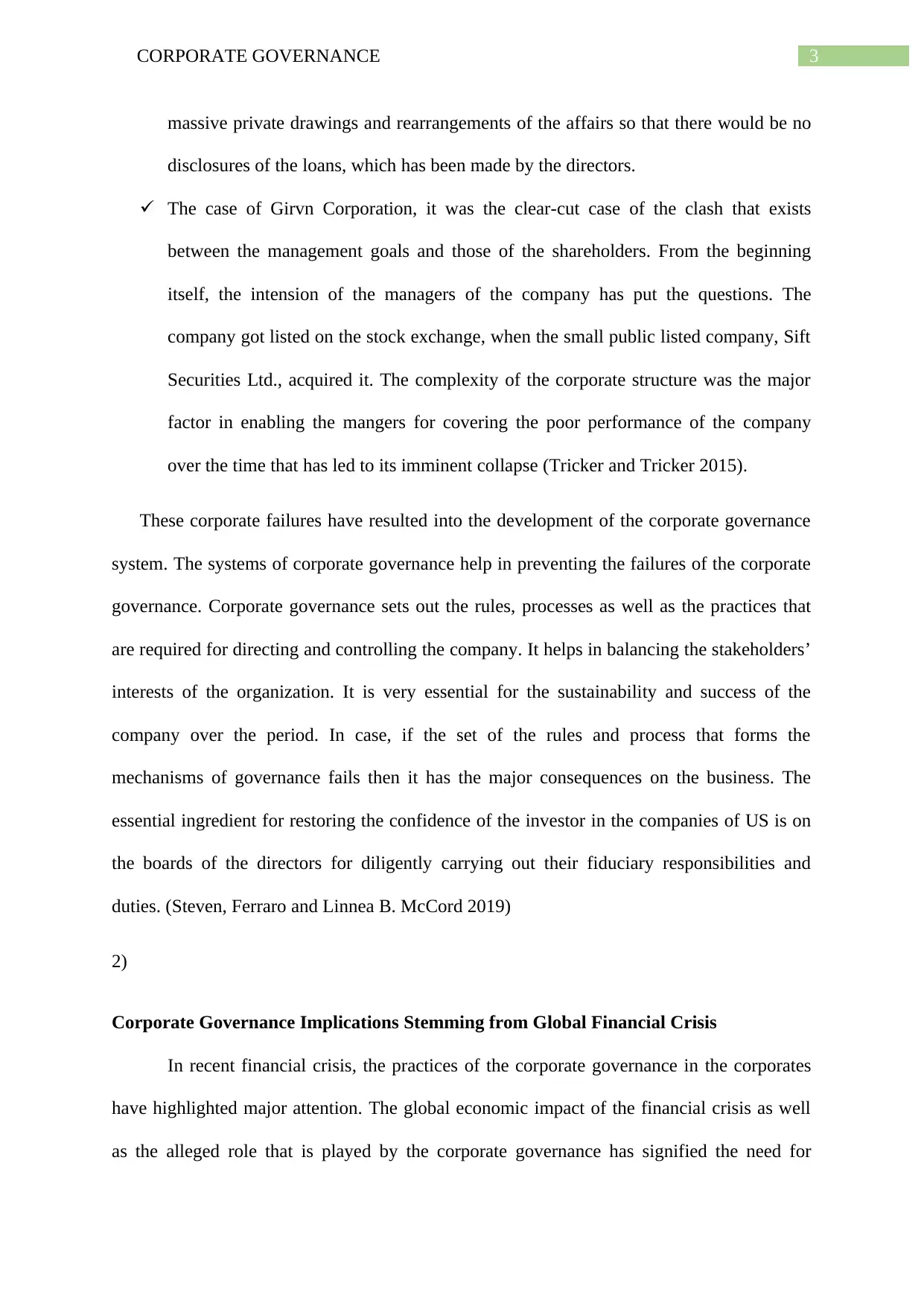
3CORPORATE GOVERNANCE
massive private drawings and rearrangements of the affairs so that there would be no
disclosures of the loans, which has been made by the directors.
The case of Girvn Corporation, it was the clear-cut case of the clash that exists
between the management goals and those of the shareholders. From the beginning
itself, the intension of the managers of the company has put the questions. The
company got listed on the stock exchange, when the small public listed company, Sift
Securities Ltd., acquired it. The complexity of the corporate structure was the major
factor in enabling the mangers for covering the poor performance of the company
over the time that has led to its imminent collapse (Tricker and Tricker 2015).
These corporate failures have resulted into the development of the corporate governance
system. The systems of corporate governance help in preventing the failures of the corporate
governance. Corporate governance sets out the rules, processes as well as the practices that
are required for directing and controlling the company. It helps in balancing the stakeholders’
interests of the organization. It is very essential for the sustainability and success of the
company over the period. In case, if the set of the rules and process that forms the
mechanisms of governance fails then it has the major consequences on the business. The
essential ingredient for restoring the confidence of the investor in the companies of US is on
the boards of the directors for diligently carrying out their fiduciary responsibilities and
duties. (Steven, Ferraro and Linnea B. McCord 2019)
2)
Corporate Governance Implications Stemming from Global Financial Crisis
In recent financial crisis, the practices of the corporate governance in the corporates
have highlighted major attention. The global economic impact of the financial crisis as well
as the alleged role that is played by the corporate governance has signified the need for
massive private drawings and rearrangements of the affairs so that there would be no
disclosures of the loans, which has been made by the directors.
The case of Girvn Corporation, it was the clear-cut case of the clash that exists
between the management goals and those of the shareholders. From the beginning
itself, the intension of the managers of the company has put the questions. The
company got listed on the stock exchange, when the small public listed company, Sift
Securities Ltd., acquired it. The complexity of the corporate structure was the major
factor in enabling the mangers for covering the poor performance of the company
over the time that has led to its imminent collapse (Tricker and Tricker 2015).
These corporate failures have resulted into the development of the corporate governance
system. The systems of corporate governance help in preventing the failures of the corporate
governance. Corporate governance sets out the rules, processes as well as the practices that
are required for directing and controlling the company. It helps in balancing the stakeholders’
interests of the organization. It is very essential for the sustainability and success of the
company over the period. In case, if the set of the rules and process that forms the
mechanisms of governance fails then it has the major consequences on the business. The
essential ingredient for restoring the confidence of the investor in the companies of US is on
the boards of the directors for diligently carrying out their fiduciary responsibilities and
duties. (Steven, Ferraro and Linnea B. McCord 2019)
2)
Corporate Governance Implications Stemming from Global Financial Crisis
In recent financial crisis, the practices of the corporate governance in the corporates
have highlighted major attention. The global economic impact of the financial crisis as well
as the alleged role that is played by the corporate governance has signified the need for
Paraphrase This Document
Need a fresh take? Get an instant paraphrase of this document with our AI Paraphraser
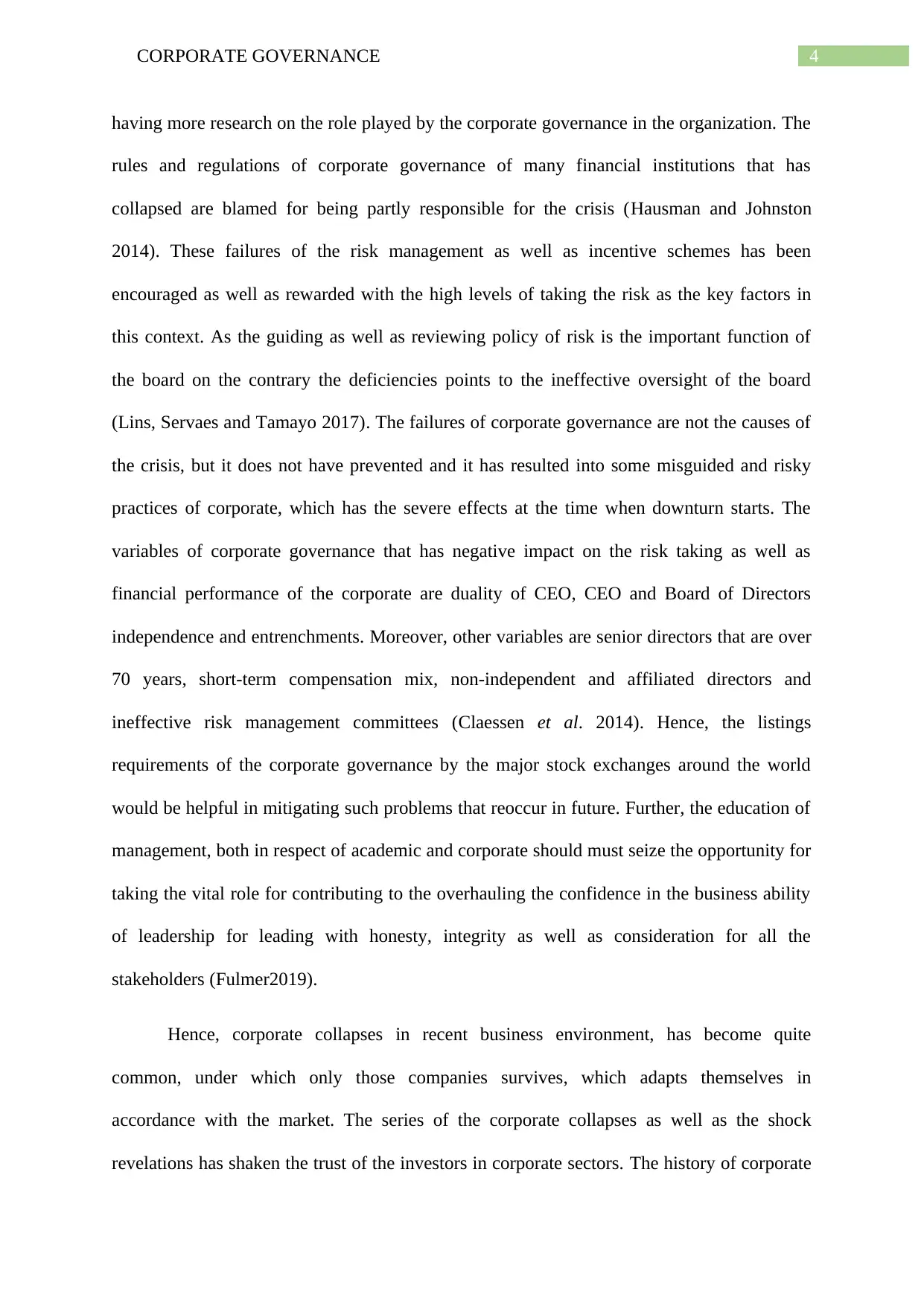
4CORPORATE GOVERNANCE
having more research on the role played by the corporate governance in the organization. The
rules and regulations of corporate governance of many financial institutions that has
collapsed are blamed for being partly responsible for the crisis (Hausman and Johnston
2014). These failures of the risk management as well as incentive schemes has been
encouraged as well as rewarded with the high levels of taking the risk as the key factors in
this context. As the guiding as well as reviewing policy of risk is the important function of
the board on the contrary the deficiencies points to the ineffective oversight of the board
(Lins, Servaes and Tamayo 2017). The failures of corporate governance are not the causes of
the crisis, but it does not have prevented and it has resulted into some misguided and risky
practices of corporate, which has the severe effects at the time when downturn starts. The
variables of corporate governance that has negative impact on the risk taking as well as
financial performance of the corporate are duality of CEO, CEO and Board of Directors
independence and entrenchments. Moreover, other variables are senior directors that are over
70 years, short-term compensation mix, non-independent and affiliated directors and
ineffective risk management committees (Claessen et al. 2014). Hence, the listings
requirements of the corporate governance by the major stock exchanges around the world
would be helpful in mitigating such problems that reoccur in future. Further, the education of
management, both in respect of academic and corporate should must seize the opportunity for
taking the vital role for contributing to the overhauling the confidence in the business ability
of leadership for leading with honesty, integrity as well as consideration for all the
stakeholders (Fulmer2019).
Hence, corporate collapses in recent business environment, has become quite
common, under which only those companies survives, which adapts themselves in
accordance with the market. The series of the corporate collapses as well as the shock
revelations has shaken the trust of the investors in corporate sectors. The history of corporate
having more research on the role played by the corporate governance in the organization. The
rules and regulations of corporate governance of many financial institutions that has
collapsed are blamed for being partly responsible for the crisis (Hausman and Johnston
2014). These failures of the risk management as well as incentive schemes has been
encouraged as well as rewarded with the high levels of taking the risk as the key factors in
this context. As the guiding as well as reviewing policy of risk is the important function of
the board on the contrary the deficiencies points to the ineffective oversight of the board
(Lins, Servaes and Tamayo 2017). The failures of corporate governance are not the causes of
the crisis, but it does not have prevented and it has resulted into some misguided and risky
practices of corporate, which has the severe effects at the time when downturn starts. The
variables of corporate governance that has negative impact on the risk taking as well as
financial performance of the corporate are duality of CEO, CEO and Board of Directors
independence and entrenchments. Moreover, other variables are senior directors that are over
70 years, short-term compensation mix, non-independent and affiliated directors and
ineffective risk management committees (Claessen et al. 2014). Hence, the listings
requirements of the corporate governance by the major stock exchanges around the world
would be helpful in mitigating such problems that reoccur in future. Further, the education of
management, both in respect of academic and corporate should must seize the opportunity for
taking the vital role for contributing to the overhauling the confidence in the business ability
of leadership for leading with honesty, integrity as well as consideration for all the
stakeholders (Fulmer2019).
Hence, corporate collapses in recent business environment, has become quite
common, under which only those companies survives, which adapts themselves in
accordance with the market. The series of the corporate collapses as well as the shock
revelations has shaken the trust of the investors in corporate sectors. The history of corporate
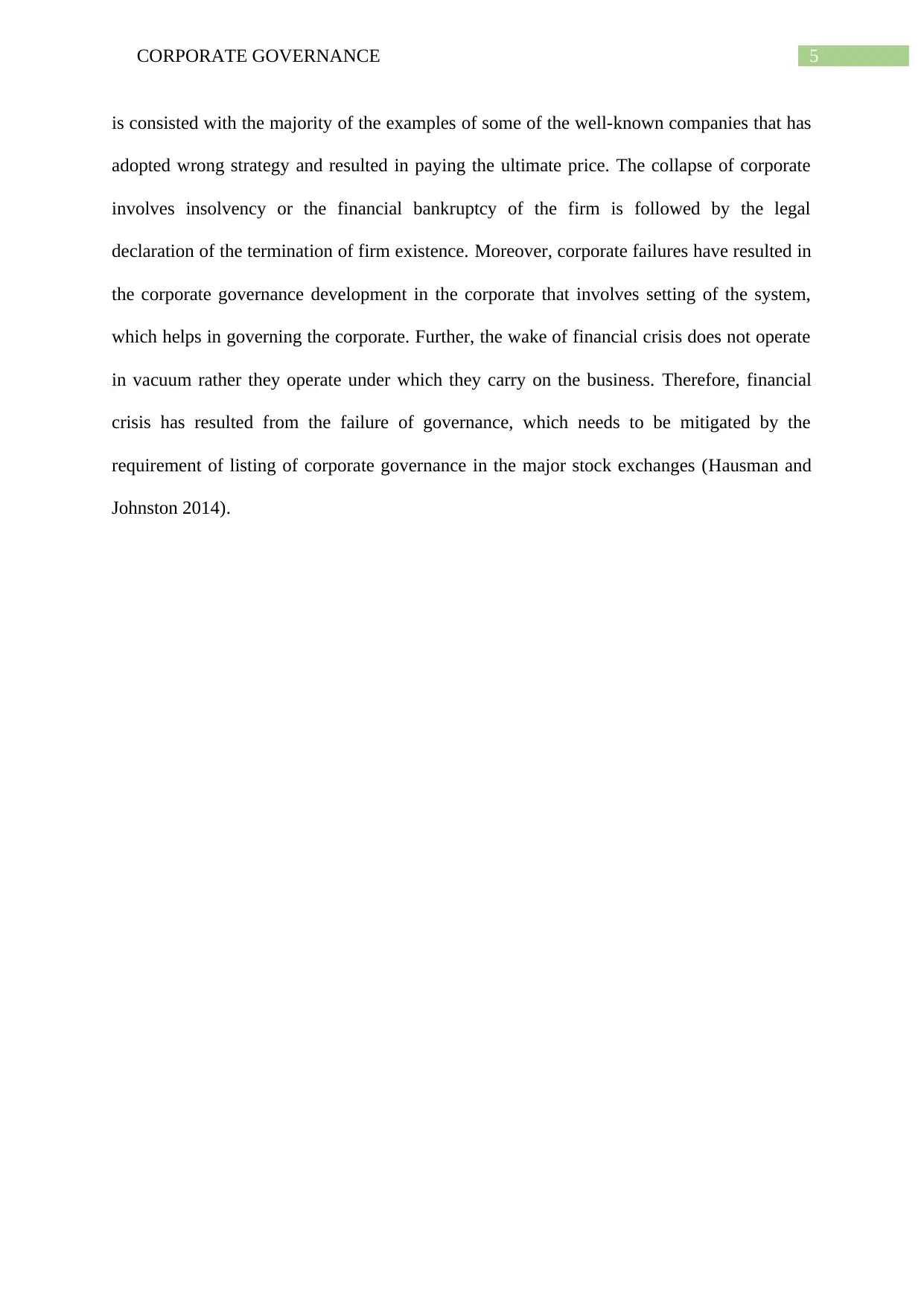
5CORPORATE GOVERNANCE
is consisted with the majority of the examples of some of the well-known companies that has
adopted wrong strategy and resulted in paying the ultimate price. The collapse of corporate
involves insolvency or the financial bankruptcy of the firm is followed by the legal
declaration of the termination of firm existence. Moreover, corporate failures have resulted in
the corporate governance development in the corporate that involves setting of the system,
which helps in governing the corporate. Further, the wake of financial crisis does not operate
in vacuum rather they operate under which they carry on the business. Therefore, financial
crisis has resulted from the failure of governance, which needs to be mitigated by the
requirement of listing of corporate governance in the major stock exchanges (Hausman and
Johnston 2014).
is consisted with the majority of the examples of some of the well-known companies that has
adopted wrong strategy and resulted in paying the ultimate price. The collapse of corporate
involves insolvency or the financial bankruptcy of the firm is followed by the legal
declaration of the termination of firm existence. Moreover, corporate failures have resulted in
the corporate governance development in the corporate that involves setting of the system,
which helps in governing the corporate. Further, the wake of financial crisis does not operate
in vacuum rather they operate under which they carry on the business. Therefore, financial
crisis has resulted from the failure of governance, which needs to be mitigated by the
requirement of listing of corporate governance in the major stock exchanges (Hausman and
Johnston 2014).
⊘ This is a preview!⊘
Do you want full access?
Subscribe today to unlock all pages.

Trusted by 1+ million students worldwide
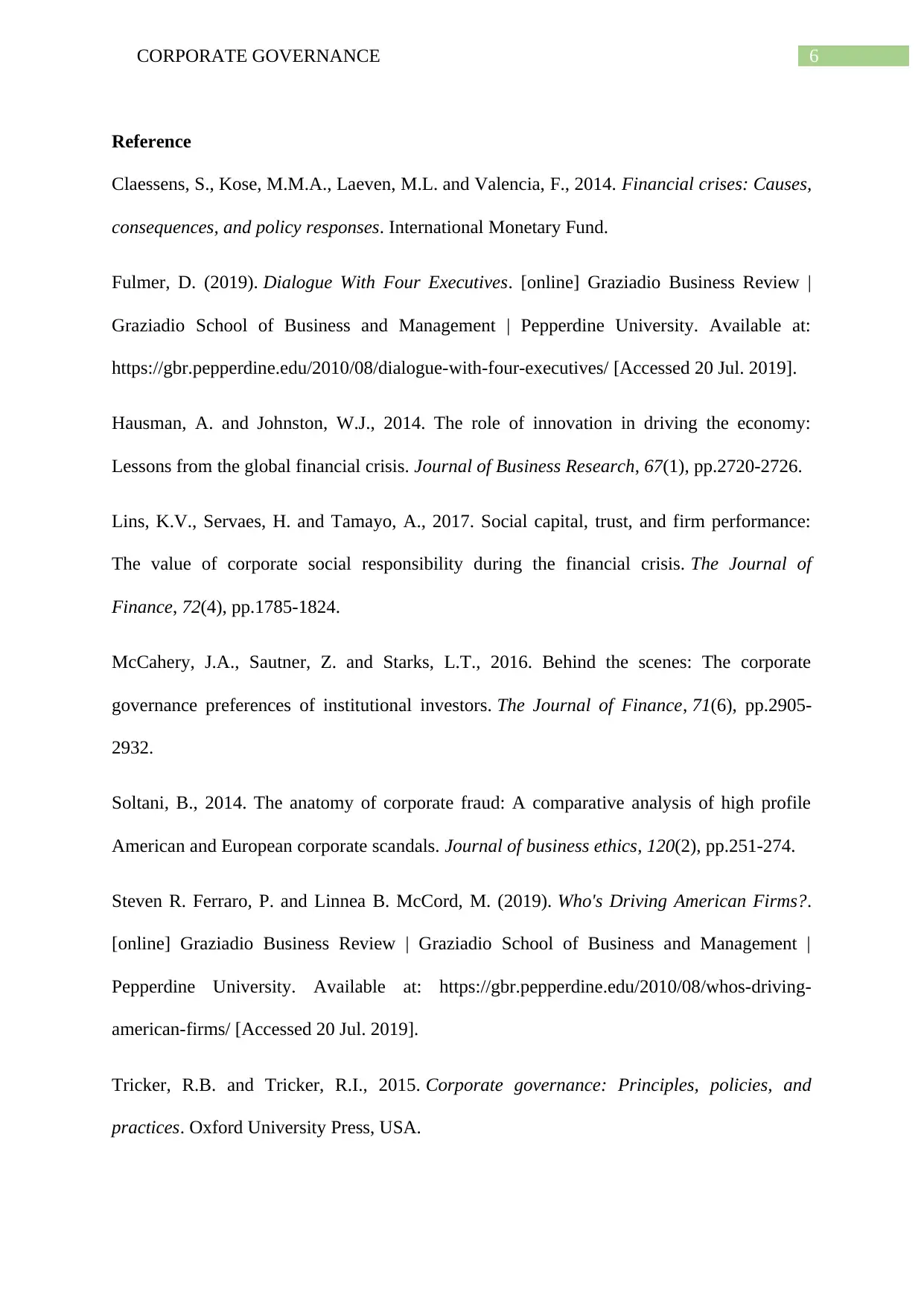
6CORPORATE GOVERNANCE
Reference
Claessens, S., Kose, M.M.A., Laeven, M.L. and Valencia, F., 2014. Financial crises: Causes,
consequences, and policy responses. International Monetary Fund.
Fulmer, D. (2019). Dialogue With Four Executives. [online] Graziadio Business Review |
Graziadio School of Business and Management | Pepperdine University. Available at:
https://gbr.pepperdine.edu/2010/08/dialogue-with-four-executives/ [Accessed 20 Jul. 2019].
Hausman, A. and Johnston, W.J., 2014. The role of innovation in driving the economy:
Lessons from the global financial crisis. Journal of Business Research, 67(1), pp.2720-2726.
Lins, K.V., Servaes, H. and Tamayo, A., 2017. Social capital, trust, and firm performance:
The value of corporate social responsibility during the financial crisis. The Journal of
Finance, 72(4), pp.1785-1824.
McCahery, J.A., Sautner, Z. and Starks, L.T., 2016. Behind the scenes: The corporate
governance preferences of institutional investors. The Journal of Finance, 71(6), pp.2905-
2932.
Soltani, B., 2014. The anatomy of corporate fraud: A comparative analysis of high profile
American and European corporate scandals. Journal of business ethics, 120(2), pp.251-274.
Steven R. Ferraro, P. and Linnea B. McCord, M. (2019). Who's Driving American Firms?.
[online] Graziadio Business Review | Graziadio School of Business and Management |
Pepperdine University. Available at: https://gbr.pepperdine.edu/2010/08/whos-driving-
american-firms/ [Accessed 20 Jul. 2019].
Tricker, R.B. and Tricker, R.I., 2015. Corporate governance: Principles, policies, and
practices. Oxford University Press, USA.
Reference
Claessens, S., Kose, M.M.A., Laeven, M.L. and Valencia, F., 2014. Financial crises: Causes,
consequences, and policy responses. International Monetary Fund.
Fulmer, D. (2019). Dialogue With Four Executives. [online] Graziadio Business Review |
Graziadio School of Business and Management | Pepperdine University. Available at:
https://gbr.pepperdine.edu/2010/08/dialogue-with-four-executives/ [Accessed 20 Jul. 2019].
Hausman, A. and Johnston, W.J., 2014. The role of innovation in driving the economy:
Lessons from the global financial crisis. Journal of Business Research, 67(1), pp.2720-2726.
Lins, K.V., Servaes, H. and Tamayo, A., 2017. Social capital, trust, and firm performance:
The value of corporate social responsibility during the financial crisis. The Journal of
Finance, 72(4), pp.1785-1824.
McCahery, J.A., Sautner, Z. and Starks, L.T., 2016. Behind the scenes: The corporate
governance preferences of institutional investors. The Journal of Finance, 71(6), pp.2905-
2932.
Soltani, B., 2014. The anatomy of corporate fraud: A comparative analysis of high profile
American and European corporate scandals. Journal of business ethics, 120(2), pp.251-274.
Steven R. Ferraro, P. and Linnea B. McCord, M. (2019). Who's Driving American Firms?.
[online] Graziadio Business Review | Graziadio School of Business and Management |
Pepperdine University. Available at: https://gbr.pepperdine.edu/2010/08/whos-driving-
american-firms/ [Accessed 20 Jul. 2019].
Tricker, R.B. and Tricker, R.I., 2015. Corporate governance: Principles, policies, and
practices. Oxford University Press, USA.
1 out of 7
Related Documents
Your All-in-One AI-Powered Toolkit for Academic Success.
+13062052269
info@desklib.com
Available 24*7 on WhatsApp / Email
![[object Object]](/_next/static/media/star-bottom.7253800d.svg)
Unlock your academic potential
Copyright © 2020–2025 A2Z Services. All Rights Reserved. Developed and managed by ZUCOL.




